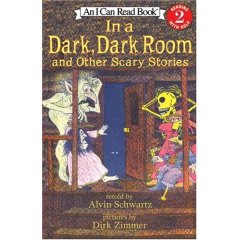
Book Review: IN A DARK, DARK ROOM
*NOTE: This book review was created for a class at TWU.
1. BIBLIOGRAPHY
Schwartz, Alvin. IN A DARK, DARK ROOM. Ill. by Dirk Zimmer. New York, NY: HarperCollins Publishers. ISBN 0060252715
2. PLOT SUMMARY
Alvin Schwartz retells seven scary stories from around the world in this "I Can Read" book geared toward children K-3. The stories range in subject matter from ghosts in a graveyard, a headless woman, close encounters with the undead, and pirates.
3. CRITICAL ANALYSIS
Alvin Schwartz has produced a selection of scary stories gathered from around the world in the "I Can Read" book entitled, IN A DARK, DARK ROOM. This is only one of several volumes by Schwartz in which he gathers stories from around the world and retells them, in this case in language that could be easily read by a child aged K-3. The author appears to have carefully selected a range of stories that fit well into the traditional literature and children's literature genres. For instance, in stories such as "The Teeth" and "In the Graveyard," elements of repetition found in traditional literature combine with patterns found in predictable children's books to engage readers and encourage participation in a format with which they are both comfortable and familiar. The interjection "oooh!" is repeated by the fat woman in "In the Graveyard" every other line, inviting the audience to call out along with her. Similarly, the title story from the volume, "In a Dark, Dark Room," uses repetition and patterning in a cumulative tale much like "The House That Jack Built," but with a spooky surprise at the end. Schwartz even includes poetry with the short rhyming piece "The Ghost of John." It is interesting to note that the rhymed words "John," "gone," and "on," are all spelled differently, reinforcing for the emergent reader that rhyming words sound the same, but can be spelled differently.
While the stories have scary elements, Schwartz's foreword and the illustrations keep the tone of the volume light. In the forward, the author writes that, "Most of us like scary stories because we like feeling scared. When there is no real danger, feeling scared is fun." Reinforcing the feeling of fun, Dirk Zimmer's pen and ink drawings are at once colorful and humorous, and if the reader is especially observant, he will notice that most of the tales include a black cat who is patently unfrightened by the events, even when the woman's head falls off in "The Green Ribbon."
Finally, at the end of the book, Schwartz details where each folktale originated. The variety of sources is fascinating, including a Surinamian story from the 1920s and a traditional song. In true folktale fashion, none of the tales have authors with the exception of "The Ghost of John" which was the creation of an 8-year-old Californian.
At first glance, to the adult reader, IN A DARK, DARK ROOM may seem to be somewhat homogenous and lacking in cultural details. However, considering the universality of traditional literature, and the audience for whom the book was written, IN A DARK, DARK ROOM will continue to appeal to most children and be reread and retold over and over again.
4. REVIEW EXCERPT(S)
ALA Notable Children's Book
School Library Journal Best Book
BookHive.com: "It is a great book for the beginning reader who is interested in ghosts, skeletons, pirates, and other things that go bump in the night."
Booklist: "The simplicity of the easy-reading text and the comically sinister pictures are perfect for these old stories that draw you right into the suspense without spelling everything out."
5. CONNECTIONS
*Continue with retellings of American scary stories by reading books such as WHEN BIRDS COULD TALK & BATS COULD SING (ISBN 0590473727)
by Virginia Hamilton, and Paul Yee's DEAD MAN'S GOLD AND OTHER STORIES (ISBN 0888994753). Discussions could center on elements commonly found in traditional literature such as the use of repetition, time passing quickly, and settings in the distant past. Students could then note differences and discuss how, although universal, some traditional stories are colored by the culture (in the case of Hamilton's book the American South, and of Yee's book the culture of recent American immigrants from Asia) in which they are told.
*Use the stories and an investigation of Schwartz's other books as a springboard for gathering oral tales from parents, grandparents, extended family members, maybe even the residents at local retirement communities. Students could then choose a tale to type up and illustrate based on the oral interviews.
*For older students, do a unit on the oral tradition and storytelling. Students could pick on of Alvin's Schwartz's tales to learn and tell to younger students at a nearby elementary campus or public library during story hour. As part of a reading or speech class, such a unit would help students' presentation skills while building confidence in a safe environment. See websites such as "Literacy Connections" at literacyconnections.com for storytelling tips.

No comments:
Post a Comment